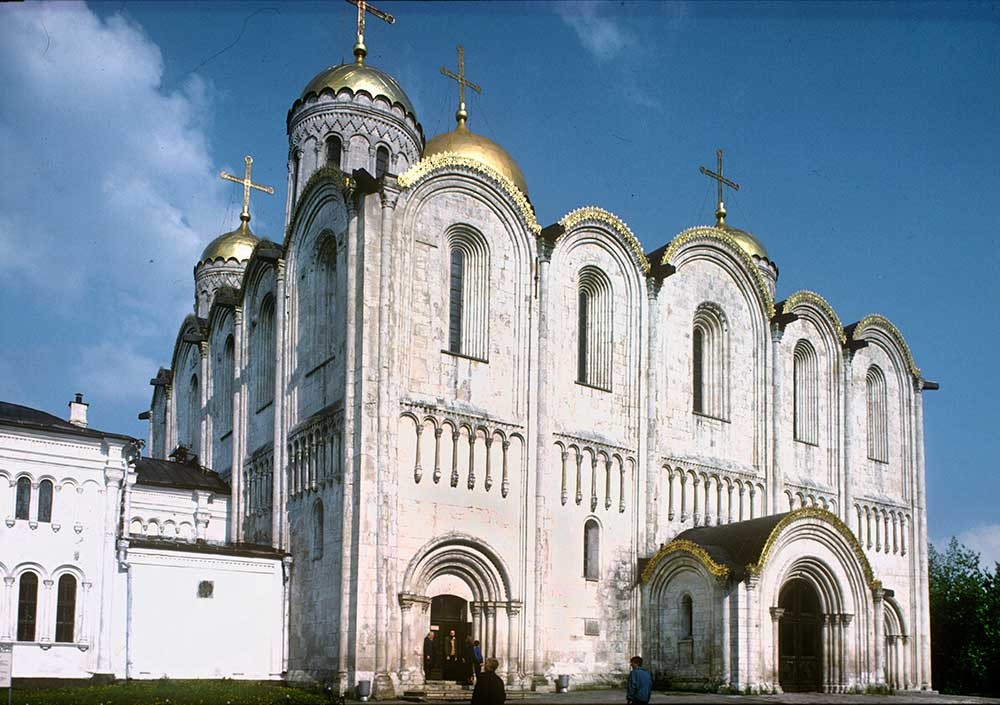
Vladimir. Cathedral of the Dormition of the Mother of God. Northwest view. May 16, 1995.
William BrumfieldAt the beginning of the 20th
Among his several views of the town are two photographs of the monumental Dormition Cathedral: a distant view from the east and a view from the northwest. My photographic work in Vladimir, including the Dormition Cathedral, spans a period from 1972 to 2009.
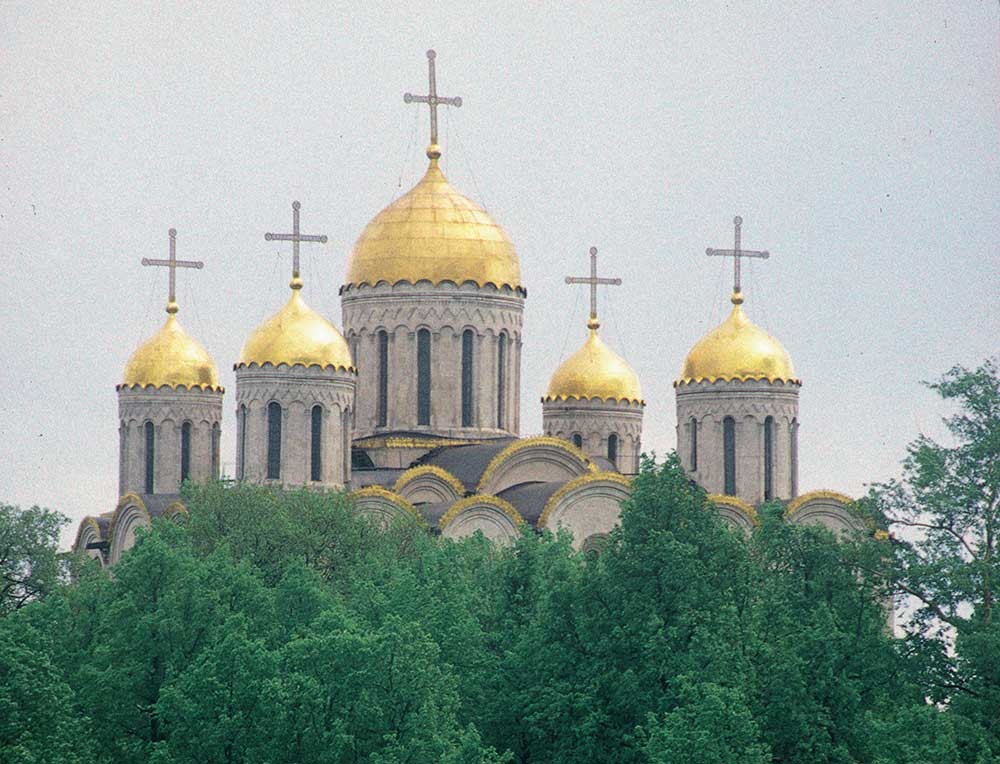
Dormition Cathedral. West view across Erofeev Descent. May 25, 1998.
William BrumfieldThe fortress of Vladimir was established in 1108 on the Klyazma River by Vladimir Monomakh, who ruled as Grand Prince
The most important of these temples was the Cathedral of the Dormition of the Mother of God (Assumption), begun in 1158 by Prince Andrei Bogoliubsky. The plan of the Dormition Cathedral conformed to the elongated plan with a dome in the center typical of large churches in Kiev and Novgorod during the same period. The stone facades displayed a few high-relief carvings.
The source of such skilled technical work remains unclear. The Laurentian chronicle mentions the bringing of masters from "all lands," and there are later references to Nemtsi, or "Germans"— a term broadly used for foreigners. It has been proposed that the artisans were sent to Bogoliubsky by Frederick Barbarossa. If certain features of the Vladimir churches — such as the portals and decorative stonework — suggest a Western Romanesque presence, the basic plan remained in the tradition of Byzantine church architecture as adapted in early medieval Rus.
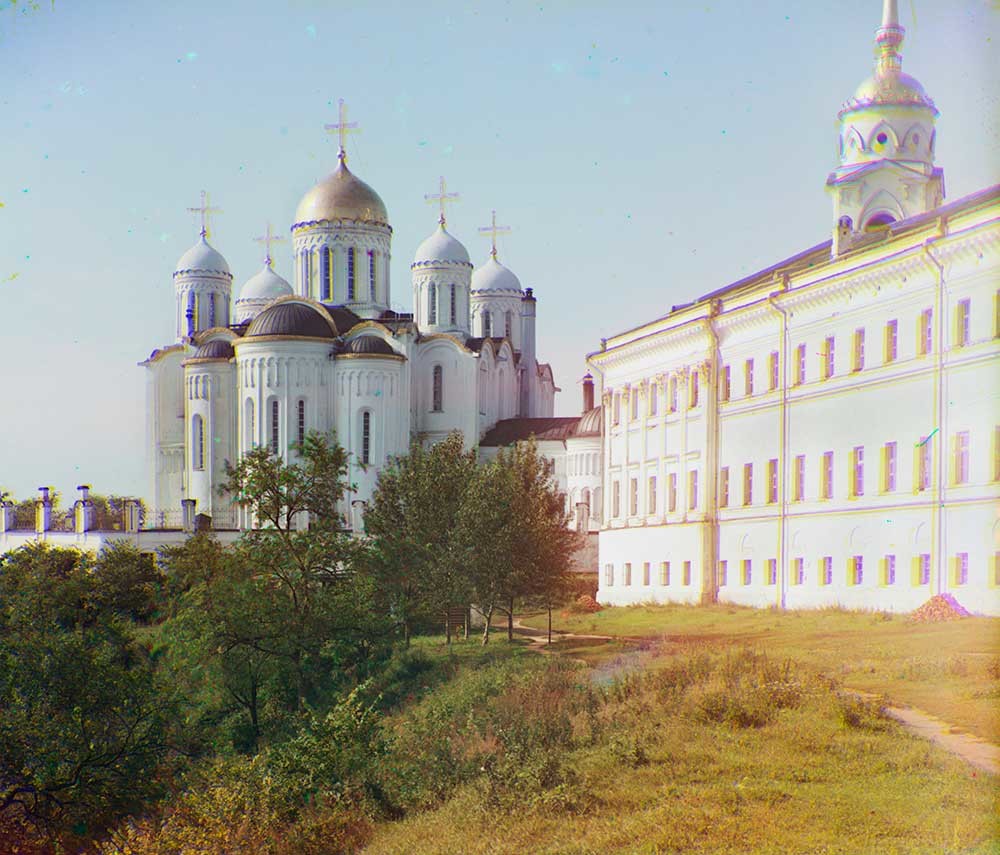
Dormition Cathedral. East view with Regional Administration (right). 1911.
Sergei Prokudin-GorskyThe Dormition Cathedral was soon rebuilt in a larger and more complex form during the reign of Andrei Bogoliubsky’s half-brother, Vsevolod III (Yurevich). The impetus for the expansion came from a fire in 1185 that destroyed much of Vladimir and severely damaged the Dormition Cathedral.
In rebuilding the cathedral (1185-90), Vsevolod's builders dismantled the attached
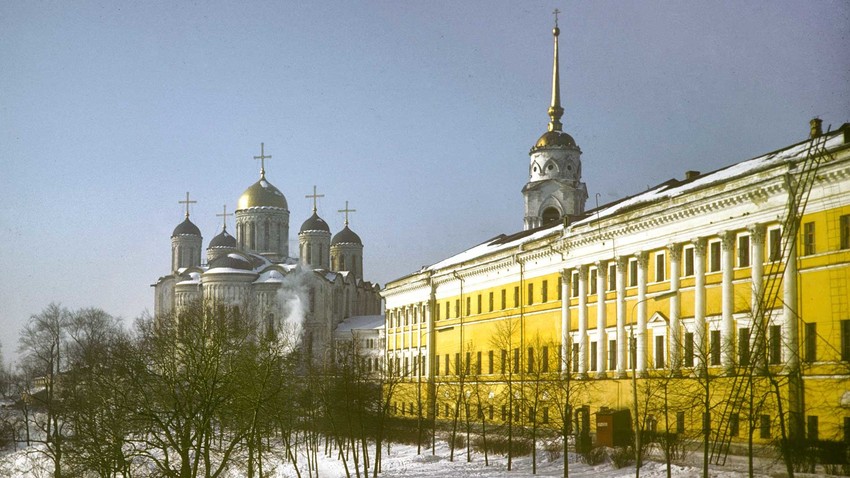
Dormition Cathedral. East view with Regional Administration (right). March 6, 1972.
William BrumfieldThe cathedral was crowned by four secondary domes placed diagonally to the main dome. On the east, the three-part apse, visible in Prokudin-Gorsky’s color photograph, was rebuilt with an increase in depth.
The new facades were marked at mid-level by an arcade frieze with accents of carved ornamentation. Some of the decorative stonework on the north and south walls was transferred from the original cathedral. The new Dormition Cathedral provided a model for the revival of architecture in Muscovy at the end of the 15th century, exemplified by the Dormition Cathedral (
Less than a
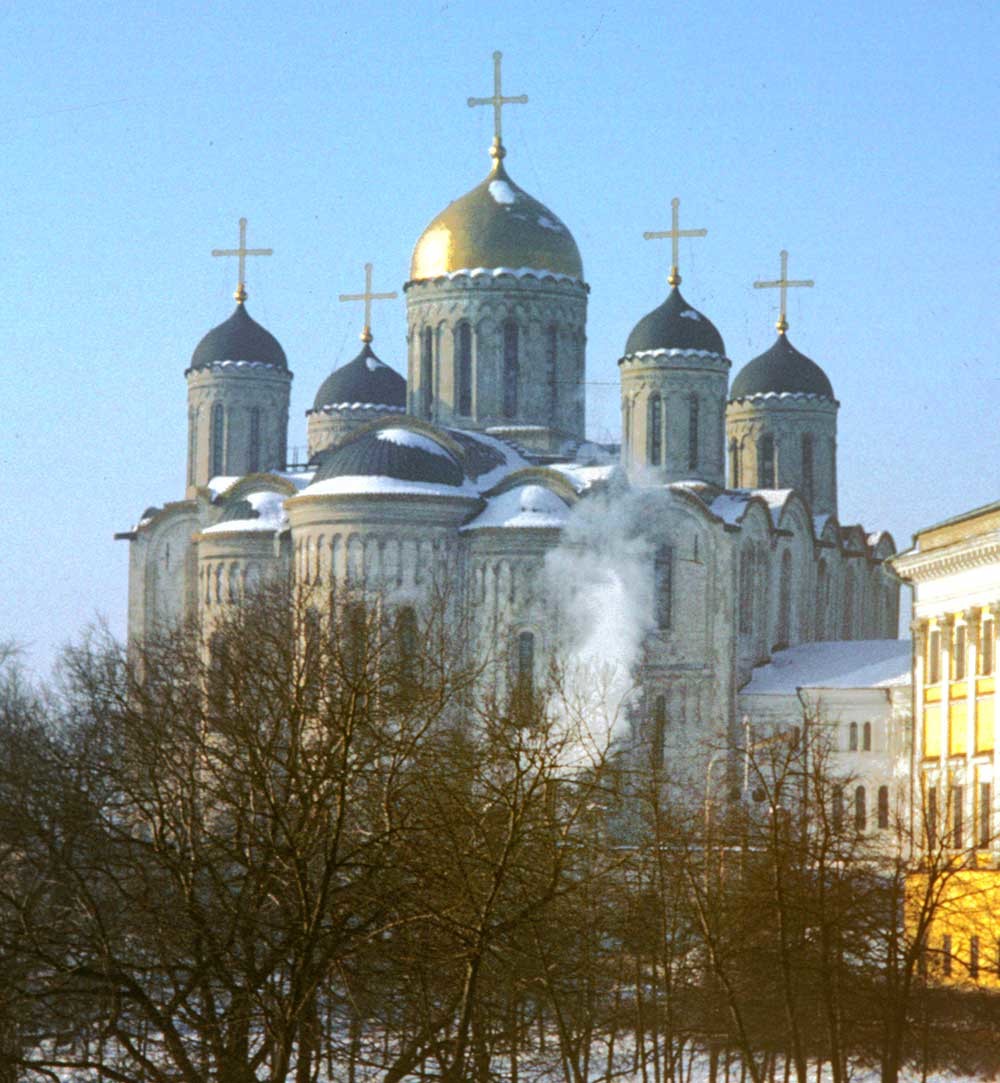
Dormition Cathedral. East view with Regional Administration (right). March 6, 1972.
William BrumfieldDespite these cataclysmic events, the Dormition Cathedral survived. Vladimir was sacked again by a large Mongol raid in 1408, during which the cathedral was ransacked and damaged. Two renowned painters, Andrei Rublev and Daniil Chorny, were brought to redo the interior. Rublev’s surviving frescoes are located in the western part of the cathedral and depict the Last Judgement. The two also painted icons for a new icon screen. Although the icon screen was redone in the Baroque style in the late 18th century, some of the Rublev icons were preserved and are now in the collection of Moscow’s Tretyakov Gallery.

Dormition Cathedral. Northeast view. June 19, 1994.
William BrumfieldIn 1785-90 the area along a bluff to the east of the Dormition was given to the construction of the Regional Administration Offices, visible in Prokudin-Gorsky’s photograph (on the right) and in mine taken six decades later. Designed in the neoclassical style favored during the reign of Catherine the Great, the long 3-story building has been criticized as a dissonant element situated between the medieval Cathedral of the Dormition and Vsevolod’s palace church, dedicated to St. Demetrius. Nonetheless, the solidly-built structure has endured and continues to serve the town.
During a visit to Vladimir in 1767, Catherine was taken by the Dormition Cathedral and personally supported its renovation, including the creation of the lavish icon screen mentioned above. Although well-intentioned, changes effected in this and subsequent decades had an impact on the cathedral’s appearance.

Dormition Cathedral. Northwest view with bell tower & Church of St. George. 1911.
Sergei Prokudin-GorskyIn 1810, a large bell tower was erected just to the north, and in 1862 a church dedicated to St. George was designed by Nicholas Artleben in a Gothic Revival style to fill the space between the bell tower and cathedral’s north façade. These additions created a new perspective on the ensemble from the north, facing the town’s main street (Moscow Street). This north perspective is clearly rendered in Prokudin-Gorsky’s contact print. The original negative is lost.
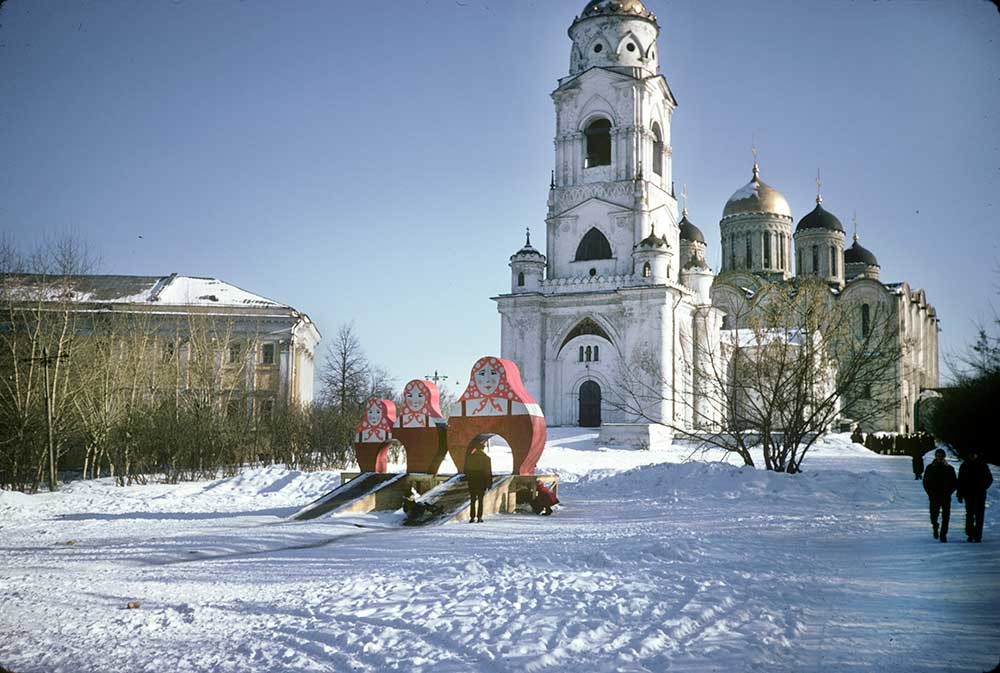
Dormition Cathedral. Northwest view with bell tower & Church of St. George. Left: Regional Administration. March 6, 1972.
William BrumfieldComprehensive, informed restoration work in the 1880s eliminated most of the distortions made during the preceding century and uncovered a major section of Andrei Rublev’s frescoes. Another prolonged restoration phase concluded in the early 1980s.
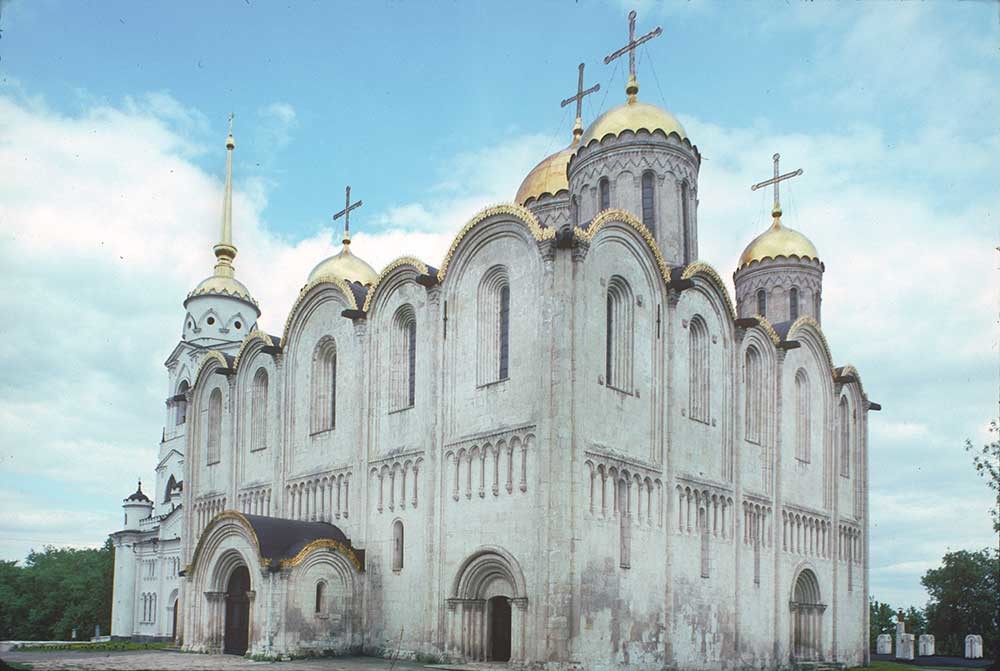
Dormition Cathedral. Southwest view. May 26, 1997.
William BrumfieldIn 1992, the Dormition Cathedral was included in the UNESCO World Heritage List. Responsibility for this grand cultural and historical monument is now shared between the Vladimir-Suzdal
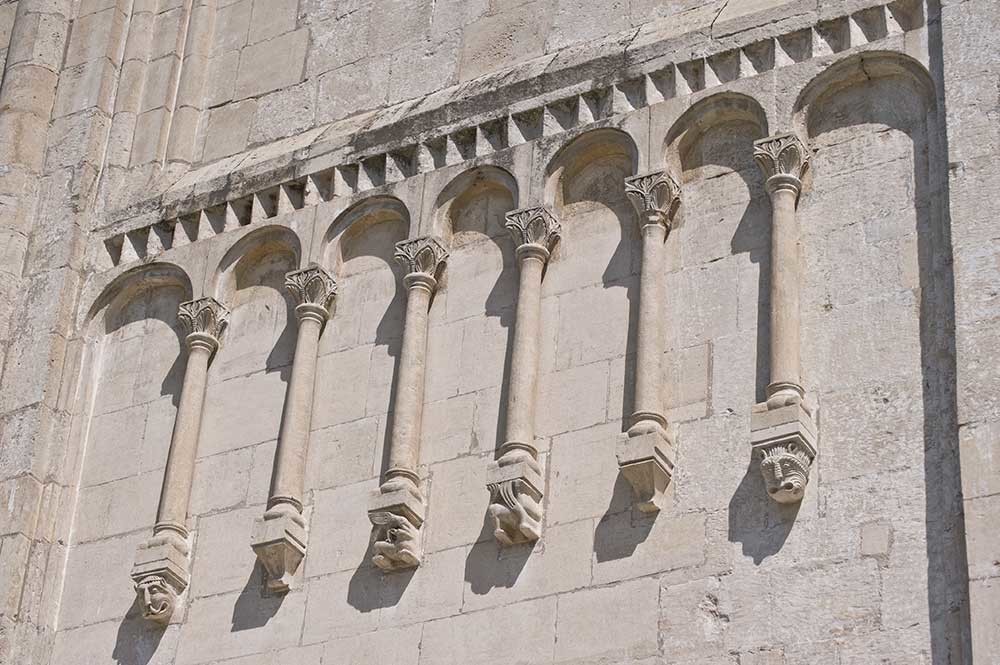
Dormition Cathedral. West facade, arcade frieze. July 18, 2009.
William BrumfieldIn the early 20th century the Russian photographer Sergei Prokudin-Gorsky invented a complex process for color photography. Between 1903 and 1916 he traveled through the Russian Empire and took over 2,000 photographs
If using any of Russia Beyond's content, partly or in full, always provide an active hyperlink to the original material.
Subscribe
to our newsletter!
Get the week's best stories straight to your inbox